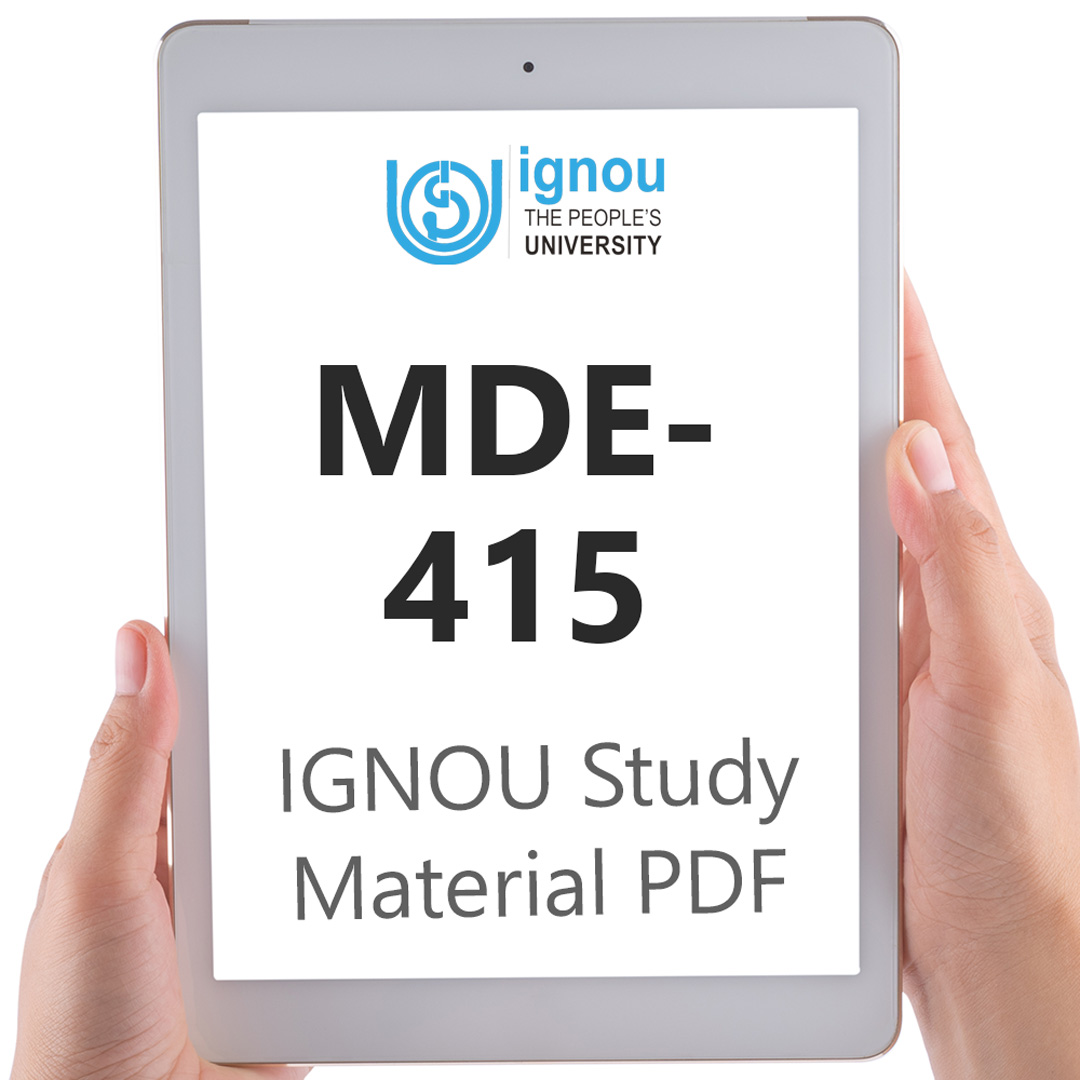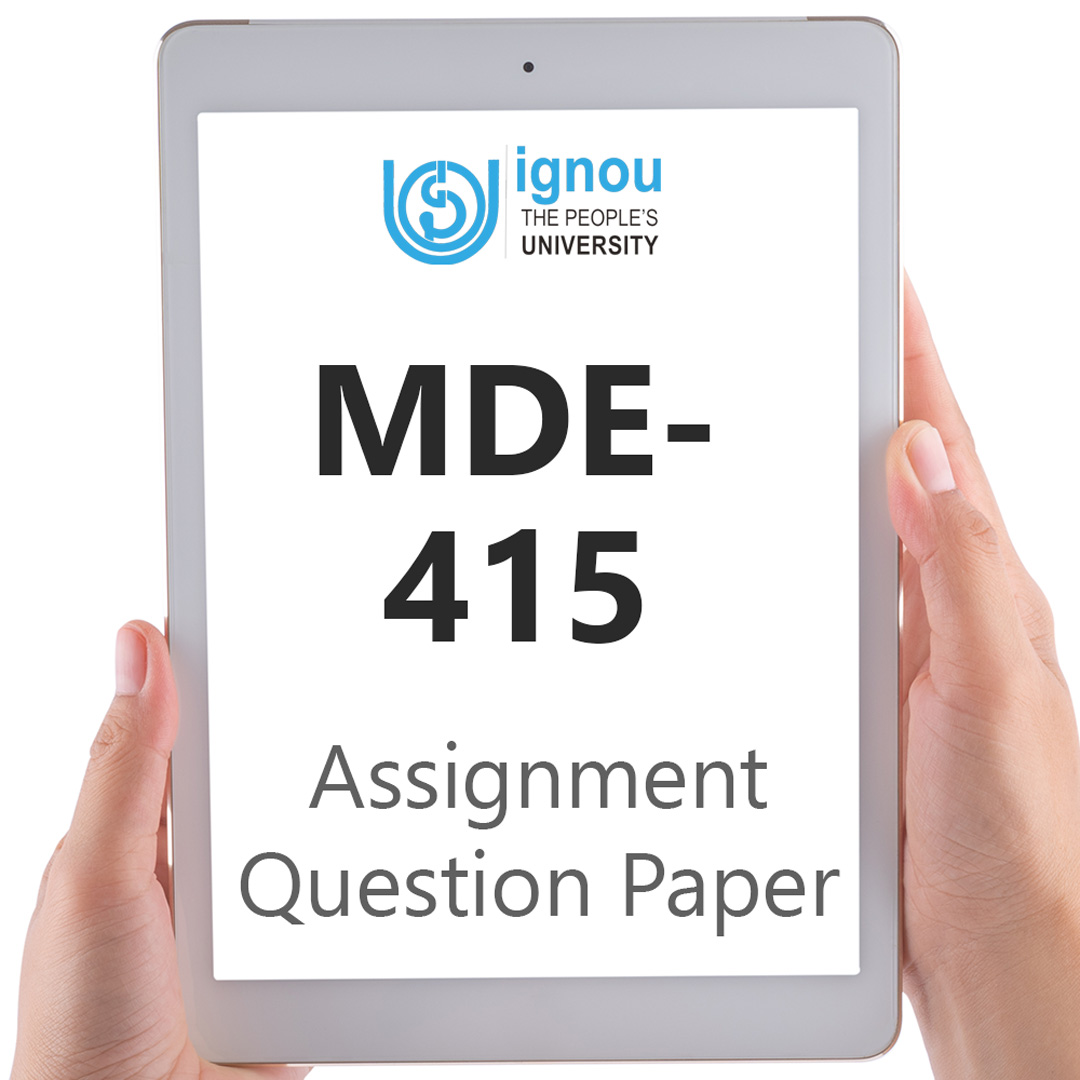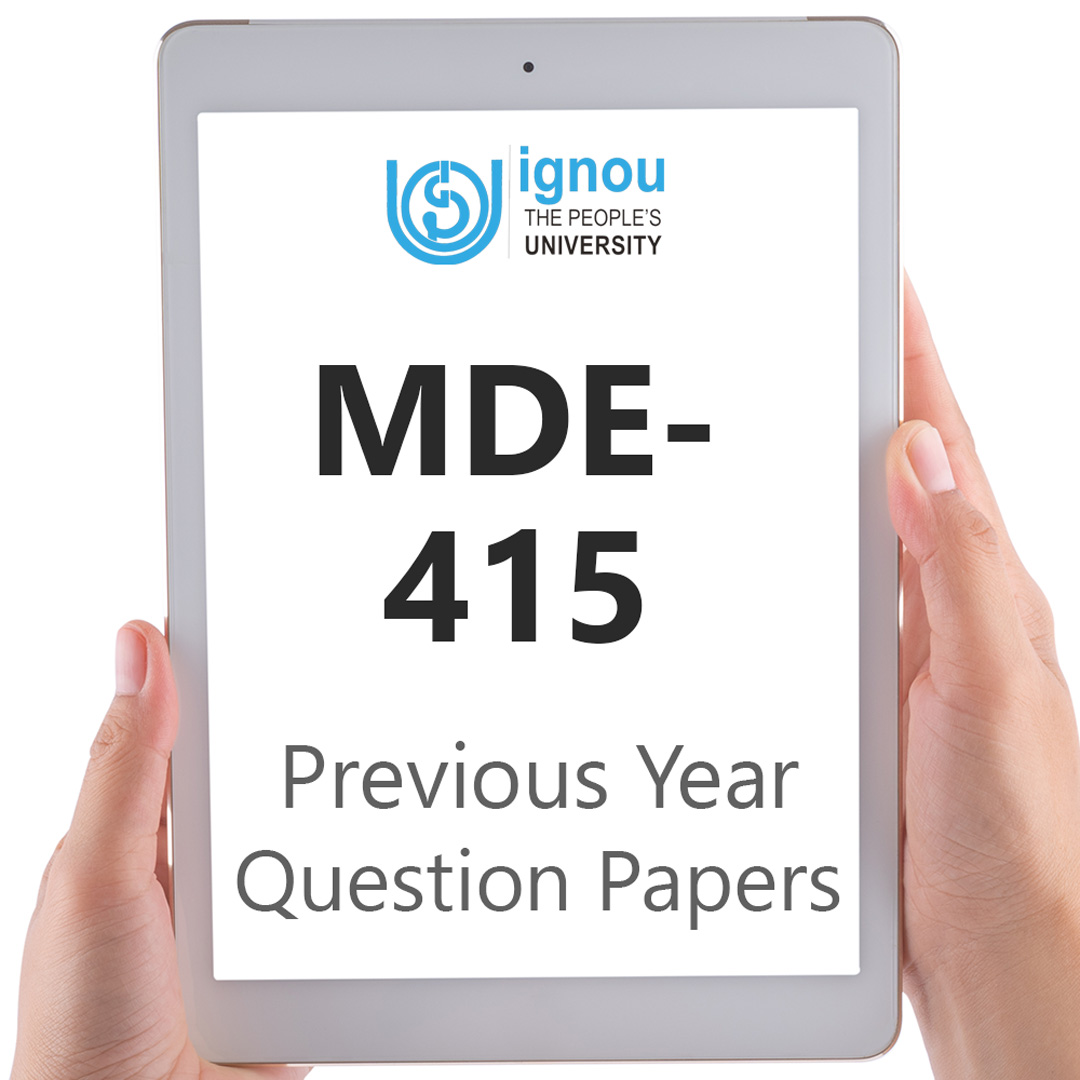If you are looking for MDE-415 IGNOU Solved Assignment solution for the subject Research Methods for Distance Education, you have come to the right place. MDE-415 solution on this page applies to 2022-23 session students studying in MADE courses of IGNOU.
MDE-415 Solved Assignment Solution by Gyaniversity
Assignment Code: MDE-415/TMA/2022-23
Course Code: MDE-415
Assignment Name: Research for Distance Education
Year: 2022-2023
Verification Status: Verified by Professor
1. Answer the following question in about 800 words.
Explain the meaning of phenomenology and how it is different from positivism.
Ans) A philosophy of knowledge called phenomenology places a strong emphasis on actual observation of phenomena. However, in contrast to positivists, phenomenologists want to perceive reality and to describe it in words as opposed to numbers: words that reflect awareness and perception. Edmund Husserl (1859–1938), who contended that the scientific method was inadequate for the study of human thought and activity, is credited with developing the intellectual underpinnings of phenomenology. Instead of focusing on causes and explanations, phenomenologists strive to create compelling descriptions of the occurrences themselves. There is no alternative for a well-told, engaging storey, and excellent ethnography is typically good phenomenology.
The term "phenomenology" needs to be defined because it is widely used to refer to any type of experientially oriented technique in today's discourse and is often used in the most general sense. The term refers to a relatively broad movement rather than a specific school or coherent approach, even within the Western philosophical tradition. A phenomenological research, broadly speaking, is one that is founded on the first-hand knowledge of elements of one's own consciousness. The human sciences are divided between a scientific approach and a humanistic-phenomenological approach. The majority of psychology research follows the quantitative, scientific tradition, yet phenomenology thrives in clinical treatment because, as its proponents persuasively argue, it is effective. The quantitative, positivistic method predominates the area of sociology, with a modest but considerable heritage of qualitative, phenomenological research.
One of the main arguments in social science research is the positivist versus phenomenological approach to the study of man and society. Many of the pioneers of sociology thought it would be feasible to develop a social science that adhered to the same rules and methods as natural sciences like chemistry and biology. Positivism is the name for this methodology. They thought this would demonstrate that "invariable laws" guided society's development. Additionally, it would demonstrate how cause-and-effect laws, which rule how matter behaves and are the subject of the natural sciences, also influence how people behave.
The behaviour of man, like the behaviour of matter, may be objectively measured. Methods of objective measurement can be developed for human behaviour, much as the behaviour of matter can be quantified by measurements like weight, temperature, and pressure. Measurements of this kind are necessary to understand behaviour. For example, in order to explain the reaction of a particular chemical to heat, it is important to offer exact measurement of temperature, weight and so on. Such measurements will enable precise observation of the behaviour of matter and generation of a cause-and-effect assertion. Such approaches and presumptions are applicable to human behaviour from a positivist perspective. In this sense, statements of cause and effect can be generated from observations of behaviour based on objective measurement. The development of theories to explain observed behaviour can then occur. It contends that non-observable aspects like meanings, emotions, and objectives are not particularly significant and may even be deceptive.
Numerous positivist presumptions are rejected by phenomenological viewpoints in social science. They contend that there are fundamental differences between the subjects covered by social and scientific sciences. The natural sciences' methodology and presumptions are therefore inadequate for the study of humans. The subject of the natural sciences is matter. They do not have meanings and purposes which direct their activity. Because of this, a natural scientist can observe, quantify, and apply an external logic to that behaviour in order to explain it. Simply because it doesn't exist, he or she is not required to investigate the inner workings of the awareness of matter.
Humans have consciousness, which includes thoughts, feelings, meanings, goals, and a sense of self, in contrast to matter. As a result, he or she defines situations and lends meaning to both his or her own acts and those of others, making their activities meaningful. As a result, he or she acts rather than just responding to outside stimuli or simply behaving. When we consider how early humans would have reacted to fire brought on by volcanoes or spontaneous combustion, we may observe that their responses to the sensation of heat were not uniform. He or she gave it a variety of interpretations, and these meanings guided his or her behaviour. For instance, he or she defined fire as a source of warmth and used it to warm their homes, as a line of defence and to scare away wild creatures, and as a source of transformation and used it to cook food and harden the points of wooden spears. Man does not just respond to fire; rather, he or she acts in accordance with the definitions that they assign to it. It is impossible for the researcher to merely observe behaviour from the outside and apply external logic to it. He or she must interpret the actor's own reasoning for action.
2. Answer the following questions in about 400 words each.
a) Describe why historical research is important in Open and Distance Education.
Ans) When addressing history and tradition, the idea of distance education growing over generations offers a useful framework. Nipper proposed three generations of remote education in 1989, linking production, distribution, and computer conferencing. Nipper was the first to adopt a generational paradigm. These three generations were afterwards referred to as computer mediated, broadcast, and correspondence. Most people agree that the first two generations are acceptable. However, successive generations have been framed substantially differently by other authors who have built on Nipper's ideas.
While Taylor claims the third generation was centred on telelearning (audio/video conferencing), Moore and Kearsley define it as adopting a systems approach. Taylor goes on to propose a fifth generation that makes use of extra "intelligent" digital technology features and a fourth generation that is linked to flexible learning based on online education. Key advances are highlighted through a generational framework. The diversity we observe points to several development strands in various environments. The idea of generations is used in the next section to explore the historical strands of distance education.
Before identifying those that make up the heritage that influences our profession, we will quickly mention important developments and difficulties encountered. It entails describing, logging, analysing, and interpreting existing situations. It incorporates some sort of contrast or comparison and looks for links between variables. A lot of study in education focuses on characterising the traits of students and the learning environment. Before we can move on to solving difficulties involving learners, institutional organisation, or the teaching of a subject, we must first understand the nature of the prevailing conditions, educational practises, and current attitudes. While this kind of research may not provide straightforward answers, it does allow for the collection of data that can be used as a starting point for additional study.
For a better understanding of the educational issues of the present, it is crucial to study the history of educational developments and changes in their social, political, and economic contexts. The decision-makers and planners, particularly with regard to policy making in education, should be aware of certain historical discoveries that may help them avoid duplicating certain policies that may have been deemed detrimental in the past. The interpretation of historical data may assist them in formulating various hypotheses regarding the current state of educational systems and, in turn, in determining the best course of action for interventions in the current educational environment. Additionally, it helps to forecast educational programmes with a respectable chance of success by analysing the tendencies of educational advancements in their historical context. The work of people involved in curriculum development, actual instruction, and day-to-day administration and organisation of educational systems is directly impacted by historical studies of educational institutions, administration, subject matter, and teaching methods.
b) Differentiate between multistage and cluster sampling.
Ans)
Cluster sampling
When the population under investigation is infinite, there is no list of population units, the geographic distribution of the units is dispersed, or sampling from individual units is not practical for a variety of administrative reasons, cluster sampling is utilised. Populations are divided into clusters, which act as the main sample units. The sample is then formed by choosing a subset of the clusters. As a result, in cluster sampling, clusters rather than individual population members or items, make up the sampling unit. For instance, instead of using instructors who teach in high schools to choose a sample of high school teachers in a state, you could choose a random sample of 10% of the high schools to act as clusters. The sample can then be made up of all the teachers at the chosen schools or a random selection of some of them. Any area that contains an intact collection of individuals with comparable traits is referred to as a cluster. Classrooms, schools, hospitals, and study centres are a few examples of clusters. Cluster sampling is cost-effective, particularly when the cost of measuring a unit is low and the cost of accessing it is high.
Multi-stage sampling
Large scale surveys employ multi-stage sampling for a more thorough analysis. It can be necessary for the researcher to use two, three, or even four stages of sampling. For instance, mailed questionnaires are frequently used in surveys to collect data from respondents in geographically dispersed places. Despite the method's low cost, incomplete questionnaires may induce bias, making it impossible to generate a representative sample. The use of two-stage sampling is required to overcome this bias. By personally getting in touch with non-respondents, a second sample is randomly chosen from the group. On this note, it is also possible to confirm the consistency of the data drawn from the first sample.
Similar to this, a researcher can select a sample of five states to represent the northern, eastern, southern, western, and central sections of the country when conducting a national survey of counsellors. A sample of 30 to 40 districts can be chosen at random from a list of all the districts in these five states. This allows for the enumeration of all the study centres located in various districts. Then, a random selection of between 300 and 400 research centres is selected. Additionally, a random sample of between 1500 and 2000 counsellors is chosen for the survey. A multistage sample is also provided through the consecutive random sampling of states, districts, study centres, and eventually counsellors. Multi-stage sampling has benefits since it lessens the stress on the respondents, is affordable, saves time, and is effective in creating the data for the sub-sample. This approach is suggested, but, only when it seems impractical to take a straightforward random sample.
3. Answer the following question in about 800 words.
Discuss various heads and sub-heads of a research report in distance education.
Ans) The various heads and sub-heads of a research report in distance education are:
Beginning
A report's opening is extremely important to the entire document. The following items are found in the opening or preliminary section of the research report, roughly in the sequence listed below:
Cover or Title Page
The report's opening pages are the cover page and the second cover page, also known as the title page. Although various colleges, universities, and sponsoring organisations specify their own formats for the title page of a project report or thesis, in general, it lists the following information in descending vertical order: the topic's title, how the report relates to a degree, course, or organisational requirement, the researcher's or author's name, and the supervisor's or guide's name (if required).
Preface including Acknowledgement
The terms Acknowledgement and Foreword are not synonymous with Preface. The rationale behind the researcher's choice of subject should be stated in the introduction. Your chance to convey to the reader why the subject of your research interested you is in the preface. It might include details from your experience performing the study, such as amusing incidents that provided insights into the information acquired, the methods used, and the outcomes and conclusions.
Table of Contents
The logical split of the report into sections and subsections is shown in the table of contents. In other words, the table of contents lists the introduction, the body of the report, and the conclusion. The right side of the table should also include page references for each chapter, section, and subsection.
List of Tables
The page listing the tables comes after the page listing the table of contents. Each table's exact title, table number, and the report page where it appeared are listed on the list.
Main Body
The actual work completed by a researcher or investigator is presented in the report's main body. From start to finish, it provides us with detailed and understandable information regarding the research or study. Because the study has been finished, the methods portion of the final report should be written in the past tense.
Introduction
A thesis or research report's introductory chapter would be this. The topic or issue under research is introduced, along with its significance. This is the first chapter:
Provides the theoretical underpinnings for the particular field of study,
Describes the issue under investigated and where it fits in relation to the larger topic of study.
Explains the importance of the current issue,
The key phrases used in the investigation and its reporting are defined,
Precisely identifies the study's goal(s),
States the study's hypothesis(s) that will be tested by statistical analysis of the data (although philosophical and historical research does not require the formulation and testing of a hypothesis) and defines the scope and bounds of the investigations.
Review of Related Literature
In most cases, a research report's second chapter is a review of the literature on the subject being investigated. The theoretical articles and papers of significant experts in the subject, as well as the abstraction of past research findings, fall under this category. This chapter serves two purposes. The researcher reads numerous books, journals, research abstracts, encyclopaedias, and other sources before settling on a problem area or just a topic for examination.
Analysis and Interpretation of Data
The research report's fourth chapter is this one. It contains the research's findings, making it the focal point of the entire document. The gathered data are tabulated and analysed using both parametric and non-parametric statistical approaches. The results are explained using the tables, and if necessary, they are also shown graphically. The figures provide facts visually for simple comprehension and comparison, rather than necessarily repeating the tables.
Main Findings and Conclusion
In a research report, this chapter is often the sixth. This chapter accurately and impartially provides the main conclusions of the study that were analysed and interpreted in the previous chapter. The fifth chapter presents the major findings in a non-technical language so that even a non-specialist such as a planner or an administrator in the field can make sense of them. The fourth chapter contains presentations that, due to the complexity involved, only a specialist or trained researcher can understand.
Writing Style
A research report is written in a different manner than other types of writing. The report's presentation should be original, clear, and brief. Simple, direct, and concise language should be used in the presentation. It should be carefully crafted to avoid being uninteresting and demotivating. The statements presented should be as accurate, objective, and free of subjectivity, personal prejudice, and persuasion as feasible. Overgeneralization must also be avoided.
Footnotes / In-text References
The author and the year of publication should always be included with any pertinent references, such as articles, papers, books, monographs, etc (Mukherjee, 1988).
The page number should also be provided if a few lines or words are truly quoted from a source, for example (Mukherjee, 1988: 120-124).
Additionally, a complete reference should be included in the report's Reference section (see sub-section 3.5.1).





